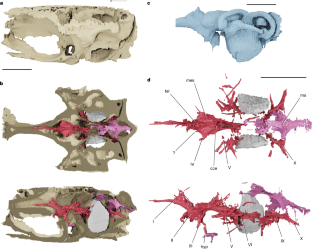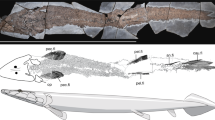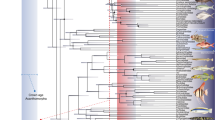Abstract
Brain anatomy provides key evidence for the relationships between ray-finned fishes1, but two major limitations obscure our understanding of neuroanatomical evolution in this major vertebrate group. First, the deepest branching living lineages are separated from the group’s common ancestor by hundreds of millions of years, with indications that aspects of their brain morphology—like other aspects of their anatomy2,3—are specialized relative to primitive conditions. Second, there are no direct constraints on brain morphology in the earliest ray-finned fishes beyond the coarse picture provided by cranial endocasts: natural or virtual infillings of void spaces within the skull4,5,6,7,8. Here we report brain and cranial nerve soft-tissue preservation in Coccocephalus wildi, an approximately 319-million-year-old ray-finned fish. This example of a well-preserved vertebrate brain provides a window into neural anatomy deep within ray-finned fish phylogeny. Coccocephalus indicates a more complicated pattern of brain evolution than suggested by living species alone, highlighting cladistian apomorphies1 and providing temporal constraints on the origin of traits uniting all extant ray-finned fishes1,9. Our findings, along with a growing set of studies in other animal groups10,11,12, point to the importance of ancient soft tissue preservation in understanding the deep evolutionary assembly of major anatomical systems outside of the narrow subset of skeletal tissues13,14,15.
This is a preview of subscription content, access via your institution
Access options
Access Nature and 54 other Nature Portfolio journals
Get Nature+, our best-value online-access subscription
$29.99 / 30 days
cancel any time
Subscribe to this journal
Receive 51 print issues and online access
$199.00 per year
only $3.90 per issue
Buy this article
- Purchase on Springer Link
- Instant access to full article PDF
Prices may be subject to local taxes which are calculated during checkout



Similar content being viewed by others
Data availability
The fossil described in this study has been deposited in the collections of the Manchester Museum and the extant specimens in the University of Michigan Museum of Zoology. The reconstructed .tiff stack, segmented Mimics file and .ply files for C. wildi are available at Zenodo (https://doi.org/10.5281/zenodo.6560305).
References
Nieuwenhuys, R., ten Donkelaar, H. J. & Nicholson, C. The Central Nervous System of Vertebrates (Springer, 1998).
Friedman, M. The early evolution of ray-finned fishes. Palaeontology 58, 213–228 (2015).
Giles, S., Xu, G. H., Near, T. J. & Friedman, M. Early members of ‘living fossil’ lineage imply later origin of modern ray-finned fishes. Nature 549, 265–268 (2017).
Moodie, R. L. A new fish brain from the coal measures of Kansas, with a review of other fossil brains. J. Comp. Neurol. 25, 135–181 (1915).
Nielsen, E. Studies on Triassic Fishes: Glaucolepis and Boreosomus. 1 (Reitzel, 1942).
Giles, S. & Friedman, M. Virtual reconstruction of endocast anatomy in early ray-finned fishes (Osteichthyes, Actinopterygii). J. Paleontol. 88, 636–651 (2014).
Lu, J., Giles, S., Friedman, M., den Blaauwen, J. L. & Zhu, M. The oldest actinopterygian highlights the cryptic early history of the hyperdiverse ray-finned fishes. Curr. Biol. 26, 1602–1608 (2016).
Edinger, T. Recent advances in paleoneurology. Prog. Brain Res. 6, 147–160 (1964).
Ikenaga, T. et al. Morphological analysis of the cerebellum and its efferent system in a basal actinopterygian fish, Polypterus senegalus. J. Comp. Neurol. 530, 1231–1246 (2022).
Ma, X., Hou, X., Edgecombe, G. D. & Strausfeld, N. J. Complex brain and optic lobes in an early Cambrian arthropod. Nature 490, 258–261 (2012).
Edgecombe, G. D., Ma, X. & Strausfeld, N. J. Unlocking the early fossil record of the arthropod central nervous system. Philos. Trans. R. Soc. B 370, 20150038 (2015).
Strausfeld, N. J., Ma, X. & Edgecombe, G. D. Fossils and the evolution of the arthropod brain. Curr. Biol. 26, R989–R1000 (2016).
Pradel, A. et al. Skull and brain of a 300-million-year-old chimaeroid fish revealed by synchrotron holotomography. Proc. Natl Acad. Sci. USA 106, 5224–5228 (2009).
Maldanis, L. et al. Heart fossilization is possible and informs the evolution of cardiac outflow tract in vertebrates. eLife 5, e14698 (2016).
Trinajstic, K. et al. Exceptional preservation of organs in Devonian placoderms from the Gogo Lagerstätte. Science 377, 1311–1314 (2022).
Braford, M. R. Stalking the everted telencephalon: comparisons of forebrain organization in basal ray-finned fishes and teleosts. Brain Behav. Evol. 74, 56–76 (2009).
Briscoe, S. D. & Ragsdale, C. W. Evolution of the chordate telencephalon. Curr. Biol. 29, R647–R662 (2019).
Nieuwenhuys, R. The development and general morphology of the telencephalon of actinopterygian fishes: synopsis, documentation and commentary. Brain Struct. Funct. 215, 141–157 (2011).
Nelson, J. S., Grande, T. C. & Wilson, M. V. H. Fishes of the World (John Wiley & Sons, 2016).
Jarvik, E. Basic Structure and Evolution of Vertebrates (Academic, 1980).
Clement, A. M., Nysjö, J., Strand, R. & Ahlberg, P. E. Brain–endocast relationship in the Australian lungfish, Neoceratodus forsteri, elucidated from tomographic data (Sarcopterygii: Dipnoi). PLoS ONE 10, e0141277 (2015).
Clement, A. M., Challands, T. J., Long, J. A. & Ahlberg, P. E. The cranial endocast of Dipnorhynchus sussmilchi (Sarcopterygii: Dipnoi) and the interrelationships of stem-group lungfishes. PeerJ 4, e2539 (2016).
Dutel, H. et al. Neurocranial development of the coelacanth and the evolution of the sarcopterygian head. Nature 569, 556–559 (2019).
Coates, M. I. Endocranial preservation of a Carboniferous actinopterygian from Lancashire, UK, and the interrelationships of primitive actinopterygians. Philos. Trans. R. Soc. B 354, 435–462 (1999).
Poplin, C. M. Etude de Quelques Paleoniscides Pennsylvaniens du Kansas (Cahiers de Paléontologie, Editions du CNRS, 1974).
Hamel, M.-H. & Poplin, C. The braincase anatomy of Lawrenciella schaefferi, actinopterygian from the Upper Carboniferous of Kansas (USA). J. Vertebr. Paleontol. 28, 989–1006 (2008).
Giles, S., Rogers, M. & Friedman, M. Bony labyrinth morphology in early neopterygian fishes (Actinopterygii: Neopterygii). J. Morphol. 279, 426–440 (2018).
Latimer, A. E. & Giles, S. A giant dapediid from the Late Triassic of Switzerland and insights into neopterygian phylogeny. R. Soc. Open Sci. 5, 180497 (2018).
Argyriou, T. et al. Internal cranial anatomy of Early Triassic species of †Saurichthys (Actinopterygii: †Saurichthyiformes): implications for the phylogenetic placement of †saurichthyiforms. BMC Evol. Biol. 18, 161 (2018).
Gignac, P. M. et al. Diffusible iodine-based contrast-enhanced computed tomography (diceCT): an emerging tool for rapid, high-resolution, 3-D imaging of metazoan soft tissues. J. Anat. 228, 889–909 (2016).
Pradel, A., Maisey, J. G., Mapes, R. H. & Kruta, I. First evidence of an intercalar bone in the braincase of “palaeonisciform” actinopterygians, with a virtual reconstruction of a new braincase of Lawrenciella Poplin, 1984 from the Carboniferous of Oklahoma. Geodiversitas 38, 489–504 (2016).
Coates, M. I. Actinopterygians from the Namurian of Bearsden, Scotland, with comments on early actinopterygian neurocrania. Zool. J. Linn. Soc. 122, 27–59 (1998).
Smeets, W. J. A. J. in The Central Nervous System of Vertebrates Vol. 1–3 (eds Nieuwenhuys, R. et al.) 551–654 (Springer, 1998).
Nieuwenhuys, R. in The Central Nervous System of Vertebrates Vol. 1–3 (eds Nieuwenhuys, R. et al.) 939–1006 (Springer, 1998).
Nieuwenhuys, R. in The Central Nervous System of Vertebrates Vol. 1–3 (eds Nieuwenhuys, R. et al.) 1007–1043 (Springer, 1998).
Northcutt, R. G. Forebrain evolution in bony fishes. Brain Res. Bull. 75, 191–205 (2008).
Morona, R., López, J. M., Northcutt, R. G. & González, A. Comparative analysis of the organization of the cholinergic system in the brains of two Holostean fishes, the Florida gar Lepisosteus platyrhincus and the bowfin Amia calva. Brain. Behav. Evol. 81, 109–142 (2013).
Bjerring, H. C. in Evolutionary Biology of Primitive Fishes (eds Foreman, R. E. et al.) 31–57 (Springer, 1985).
Chandler, A. C. On a lymphoid structure lying over the myelencephalon of Lepisosteus. Univ. Calif. Publ. Zool. 9, 85–104 (1911).
Fine, M. L., Horn, M. H. H. & Cox, B. Acanthonus armatus, a deep-sea teleost fish with a minute brain and large ears. Proc. R. Soc. Lond. B 230, 257–265 (1987).
Herzog, H., Klein, B. & Ziegler, A. Form and function of the teleost lateral line revealed using three-dimensional imaging and computational fluid dynamics. J. R. Soc. Interface 14, 20160898 (2017).
Watanabe, A. et al. Are endocasts good proxies for brain size and shape in archosaurs throughout ontogeny? J. Anat. 234, 291–305 (2019).
Rowe, T. B., Macrini, T. E. & Luo, Z.-X. Fossil evidence on origin of the mammalian brain. Science 332, 955–957 (2011).
Figueroa, R. T., Friedman, M. & Gallo, V. Cranial anatomy of the predatory actinopterygian Brazilichthys macrognathus from the Permian (Cisuralian) Pedra de Fogo Formation, Parnaíba Basin, Brazil. J. Vertebr. Paleontol. 39, e1639722 (2019).
Striedter, G. F. & Northcutt, R. G. Head size constrains forebrain development and evolution in ray-finned fishes. Evol. Dev. 8, 215–222 (2006).
Folgueira, M. et al. Morphogenesis underlying the development of the everted teleost telencephalon. Neural Develop. 7, 212 (2012).
Schmidt, M. Evolution of the hypothalamus and inferior lobe in ray-finned fishes. Brain Behav. Evol. 95, 302–316 (2020).
van der Horst, C. J. The myelencephalic gland of Polyodon, Acipenser and Amia. K. Akad. Wet. Amst. Proc. Sect. Sci. 28, 432–442 (1925).
Northcutt, R. G., Neary, T. J. & Senn, D. G. Observations on the brain of the coelacanth Latimeria chalumnae: External anatomy and quantitative analysis. J. Morphol. 155, 181–192 (1978).
White, E. G. A Classification and Phylogeny of the Elasmobranch Fishes American Museum Novitates 837 (American Museum of National History, 1936).
Lankester, E. R. & Ridewood, W. G. Guide to the Gallery of Fishes (British Museum, 1908).
Watson, D. M. S. The structure of certain palaeoniscids and the relationships of that group with other bony fish. Proc. Zool. Soc. Lond. 95, 815–870 (1925).
Poplin, C. M. & Véran, M. A revision of the actinopterygian fish Coccocephalus wildi from the Upper Carboniferous of Lancashire. Spec. Pap. Palaeontol. 52, 7–29 (1996).
Coates, M. I. & Tietjen, K. ‘This strange little palaeoniscid’: a new early actinopterygian genus, and commentary on pectoral fin conditions and function. Earth Environ. Sci. Trans. R. Soc. Edinb. 109, 15–31 (2018).
Hough, E. Geology of the Burnley area (SD82NW and SD83SW) (British Geological Survey, 2004).
Waters, C. N. et al. A Revised Correlation of Carboniferous Rocks in the British Isles (Geological Society of London, 2011).
Vannier, J., Schoenemann, B., Gillot, T., Charbonnier, S. & Clarkson, E. Exceptional preservation of eye structure in arthropod visual predators from the Middle Jurassic. Nat. Commun. 7, 10320 (2016).
Cherns, L. et al. Correlative tomography of an exceptionally preserved Jurassic ammonite implies hyponome-propelled swimming. Geology 50, 397–401 (2021).
Sansom, R. S., Gabbott, S. E. & Purnell, M. A. Atlas of vertebrate decay: a visual and taphonomic guide to fossil interpretation. Palaeontology 56, 457–474 (2013).
Sansom, R. S., Gabbott, S. E. & Purnell, M. A. Decay of vertebrate characters in hagfish and lamprey (Cyclostomata) and the implications for the vertebrate fossil record. Proc. R. Soc. B 278, 1150–1157 (2011).
Sansom, R. S. & Wills, M. A. Fossilization causes organisms to appear erroneously primitive by distorting evolutionary trees. Sci. Rep. 3, 2545 (2013).
Acknowledgements
We thank D. Gelsthorpe and L. Loughtman for access to collections; R. Nagesan and R. Singer for assistance with extant material; L. Simonitis and K. Hall for providing comparative material of Squalus; A. Capobianco, J. Díaz-Cruz and C. Mauricio Peredo for providing feedback on an earlier version of this contribution; and R. Dearden for assisting with Blender. S.G. was supported by a Royal Society Dorothy Hodgkin Research Fellowship (DH160098). This study includes data produced at the CTEES facility at University of Michigan, supported by the Department of Earth and Environmental Sciences and College of Literature, Science and the Arts.
Author information
Authors and Affiliations
Contributions
The project was conceived by M.F. and S.G. CT scanning was performed by M.F. and R.T.F., with staining of extant material by R.T.F. and M.A.K. Segmentation of CT data was performed by M.F., S.G., D.G. and R.T.F.; M.F, S.G. and R.T.F wrote the manuscript, with comments from all of the authors.
Corresponding authors
Ethics declarations
Competing interests
The authors declare no competing interests.
Peer review
Peer review information
Nature thanks Hugo Dutel and the other, anonymous, reviewer(s) for their contribution to the peer review of this work.
Additional information
Publisher’s note Springer Nature remains neutral with regard to jurisdictional claims in published maps and institutional affiliations.
Extended data figures and tables
Extended Data Fig. 1 The brain (red) and myelencephalic sheet/gland (pink) of Coccocephalus wildi and selected extant ray-finned fishes.
a, Coccocephalus wildi. b, Acipenser brevirostrum. c, Amia calva. d, Polypterus senegalus. Grey and white delimitations show margins between forebrain, midbrain and hindbrain across all taxa. Brains are shown in dorsal view and aligned at the anterior- and posteriormost points of the forebrain (olfactory bulbs, telencephalon and diencephalon) and the posteriormost point of the fourth ventricle. Scale bar = 5 mm.
Extended Data Fig. 2 Sections through the brain of Coccocephalus wildi.
a, transverse section through the anterior portion of the telencephalon. b, horizontal section through the ventral portion of the telencephalon. c, transverse section through the posterior portion of the telencephalon. d, horizontal section through the dorsal portion of the telencephalon. e, transverse section through the anterior portion of the hypothalamus inferior lobes. f, transverse section through the posterior portion of the hypothalamus inferior lobes. Inset shows where each of sections (a)-(e) intersect the brain. h.inf, inferior lobe of the hypothalamus; l.hyp.re, lateral hypothalamic recess; tel, telencephalon; tel.sept, telencephalic septum. Scale bar = 2 mm.
Extended Data Fig. 3 Transverse sections and renders of the brain of Coccocephalus wildi.
a,b, the telencephalon. c,d, the mesencephalon and hypophysis. cce, corpus cerebellum; h.inf, inferior lobe of the hypothalamus; hyp, hypophysis; tel, telencephalon; mes, mesencephalon; ms, mesencephalic sheet; v. tr?, velum transversum; 4th v, fourth ventricle; II, optic nerve; III, oculomotor nerve; IV, trochlear nerve, V, trigeminal nerve; VII, facial nerve. Dorsal portion of forebrain and velum transversum digitally removed. Scale bar in a, c = 2.5 mm; scale bar in b, d = 2 mm.
Extended Data Fig. 4 Sections through the brain of Coccocephalus wildi and Amia calva.
a, transverse section through the diencephalon and mesencephalon of Coccocephalus wildi. b, transverse section through the diencephalon and mesencephalon of Amia calva. l.hyp.re, lateral hypothalamic recess. Scale bar = 2 mm.
Extended Data Fig. 5 Sagittal sections through the neurocranium of Coccocephalus wildi showing the brain and associated structures.
cce, corpus cerebelli, cr.c; crista cerebellaris, h.inf, hypothalamus inferior lobes; hyp, hypophysis; mes, mesencephalon; ms, myelencephalic sheet; rho, rhombencephalon; sc, spinal cord; tel, telencephalon; v.tr, velum transversum; 2nd v, second ventricle; 4th v, fourth ventricle; I, olfactory nerve; II, optic nerve. Scale bar = 5 mm.
Extended Data Fig. 6 The brain of Coccocephalus wildi (red) rendered partially transparent to show brain ventricle configuration (white).
a, dorsal view. b, left lateral view. die. v, diencephalic ventricle; 2nd v, second ventricle; 4th v, fourth ventricle. Scale bar = 5 mm.
Extended Data Fig. 7 Sections through the brain of Coccocephalus wildi showing the rhombencephalic region.
a, sagittal section through the brain. b, transverse section through the anterior portion of the rhombencephalon. c, horizontal section through the mesencephalic and rhombencephalic regions of the brain. cce, corpus cerebelli, crc, crista cerebellaris, inv, invagination of the cerebellum, 4th v, fourth ventricle. Scale bar = 1 mm.
Extended Data Fig. 8 The brain of Coccocephalus wildi within the endocavity.
a, dorsal view, b, left lateral view. d.lat, dorsal lateral line nerve, hyo.VII, hyomandibular branch of the facial nerve, hyp, hypophysis, ms, mesencephalic sheet, I, olfactory nerve, II, optic nerve, IV, trochlear nerve, V, trigeminal nerve, VI, abducens nerve, VII, facial nerve, IX, glossopharyngeal nerve, X, vagus nerve. Scale bar = 5 mm.
Supplementary information
Supplementary Information
Document (PDF) including additional text detailing: phylogenetic placement of ✝Coccocephalus wildi; potential paths for the fossilization of brain tissues; CT scanning parameters for all specimens (Supplementary Table 1); and Supplementary References.
Supplementary Data
Annotated surface file (HTML) of the segmented brain of ✝Coccocephalus wildi. For visualization open file with a web browser. Produced with Blender 2.79 “Blend4Web” extension.
Supplementary Video 1
Supplementary Video (MP4) illustrating the transverse sections through the brain of ✝Coccocephalus wildi, highlighting the telencephalic septum.
Rights and permissions
Springer Nature or its licensor (e.g. a society or other partner) holds exclusive rights to this article under a publishing agreement with the author(s) or other rightsholder(s); author self-archiving of the accepted manuscript version of this article is solely governed by the terms of such publishing agreement and applicable law.
About this article
Cite this article
Figueroa, R.T., Goodvin, D., Kolmann, M.A. et al. Exceptional fossil preservation and evolution of the ray-finned fish brain. Nature 614, 486–491 (2023). https://doi.org/10.1038/s41586-022-05666-1
Received:
Accepted:
Published:
Issue Date:
DOI: https://doi.org/10.1038/s41586-022-05666-1
This article is cited by
-
Fish fossil unfolds clues to vertebrate brain evolution
Nature (2023)
-
From fossils to mind
Communications Biology (2023)
Comments
By submitting a comment you agree to abide by our Terms and Community Guidelines. If you find something abusive or that does not comply with our terms or guidelines please flag it as inappropriate.



